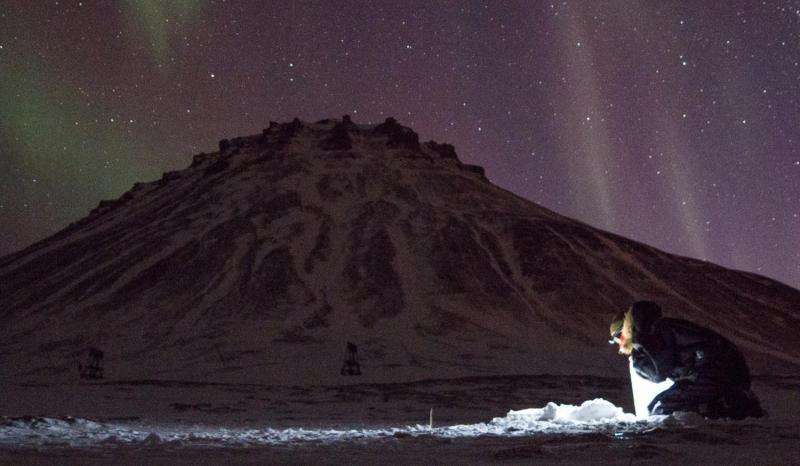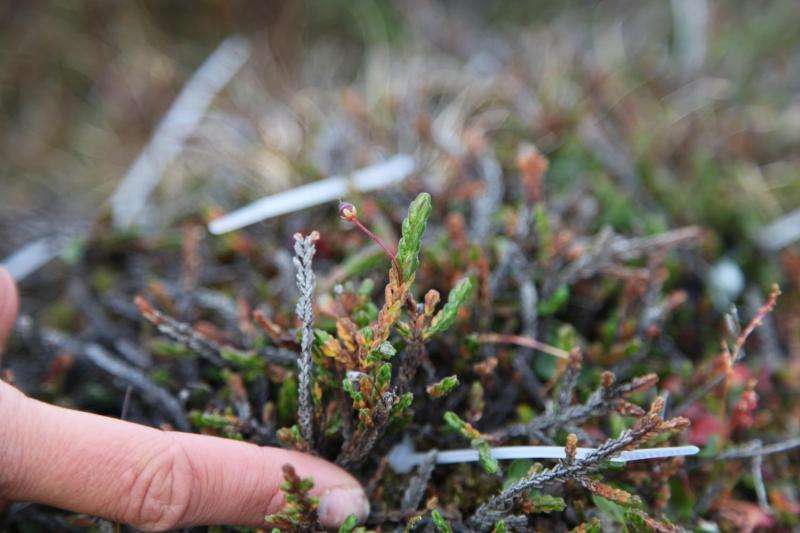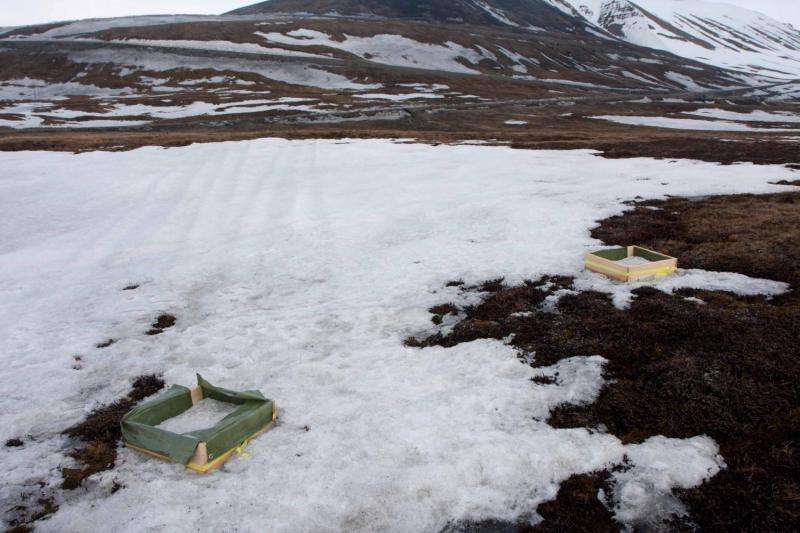Freezing plants to predict the fate of the Arctic

Global warming means much warmer winters in the Arctic, with more rain and icing. Researchers are working to understand what that will do to plants that have evolved to overwinter under a thick blanket of snow.
In January 2014, a group of researchers conducted an unusual, some might say paradoxical, experiment in the Arctic archipelago of Svalbard: Their goal was to encase small plants growing out on the tundra in a thick layer of ice.
While this might seem odd—nature does a pretty good job of encasing plants in Svalbard with ice and snow—the researchers were trying to use their experiment as a kind of biological crystal ball.
Global warming means that it will rain more in places like Svalbard during the winter, and the researchers wondered what this change in climate would do to a common tundra plant, called Cassiope tetragona, or arctic heather. This is more than just an academic question, since climatologists say that Svalbard has already seen the greatest increase in temperatures of any place in Europe over the last three decades.
"We already see large changes in Svalbard's climate, and we expect more to come" because of global warming, said Brage B. Hansen, a biologist at the Centre for Biodiversity Dynamics at the Norwegian University of Science and Technology and one of the paper's authors. "We know that when we have summer warming, plants will grow more, but when we have winter warming, which is even more profound in a place like Svalbard, we don't really know how this affects plants."

And so Hansen and his fellow scientists at the University Centre in Svalbard and the University of Aberdeen designed an experiment to see if they could figure out how Cassiope would fare encapsulated in a sheet of ice.
Ice boxes
The study, published in Ecology and Evolution in February, was what researchers call a pilot project—where they test out an idea to see if it merits pursuing.
Logistics proved to be a big part of the challenge they faced in deciding to do the study.
Outside of Longyearbyen, which has a year-round population of about 2000 people, there are a few scattered settlements but essentially no infrastructure. If the researchers wanted to freeze their plants in natural settings out on the tundra, they would have to haul every drop of water out to their selected research site via snowmobile, in the pitch black and bitter cold of the polar night.
Their experimental design involved using 50 x 50 cm wooden, bottomless boxes, or frames, to isolate areas of Cassiope so that they could create a thick cover of ice inside the box. "We were testing out our ideas and logistics and started out relatively small, with six boxes where we encased plants in ice, and six control plots for later comparison with untreated plants," says Øystein Varpe, associate professor at the University Centre in Svalbard.
Then came the surprisingly difficult challenge of actually encasing the plants in ice. The researchers used 40 litres of water to freeze the plants inside each of the bottomless treatment boxes. They quickly learned if they poured water into the open-bottomed boxes too quickly it would just run out the bottom. If they ran out of water they had to drive back to Longyearbyen to tank up again, so every lost drop added to the difficulty of getting the experiment set up. They finally came up with a system where they built slushy walls of snow around the perimeter of the boxes to hold the water in until it could freeze.

"It's a cold, wet and challenging job when it is -15 C and you are working with water," Hansen said. "You have to work pretty hard to make it work."
More damage but more growth
When summer came and the researchers returned to see the effects of the icing, they found that the plants that had been encased in ice were more likely to have damage. Cassiope is actually a tiny shrub that grows by either prolonging its shoots or sending up new shoots. "The icing treatment damaged and actually killed some of the plant's shoots and the ice-encased plants also flowered less," Varpe said. Neither of these findings surprised the team.
But what did surprise them was that plants that had been encased by ice actually had more growth in their remaining undamaged shoots compared to the plants in the control plots. Initially, that didn't make sense—if a plant had been harmed by freezing, why would it grow more?
Hansen said he and his colleagues believe this happened because the plants were compensating for the damage. If they had fewer shoots (because some had been killed off) and didn't put energy into making flowers, the energy that might have gone into flowering and supporting the dead shoots could instead be channeled to the surviving parts of the plant, he said.
"Maybe this reflects their life history strategy," he said, adding that the scientists are speculating and don't yet have definitive proof for the cause. "If you have really bad conditions, you skip reproduction and some stems die, but you allocate more of your resources to the growth of the remaining stems."
Even though they had relatively few sample plots to analyse, the trend was so strong that it was statistically significant.

Cassiope as a measure of past weather events
One reason the researchers decided to study Cassiope is because of the way it grows and how other researchers have used this distinctive growth pattern in climate research.
Researchers have long used tree rings as a kind of time machine, especially when it comes to weather and climate. In temperate deciduous forests, for example, a tree adds growth around its trunk each year. This ring of growth is visible when you cut the tree down and look at the distinctive pattern of concentric rings in the cross-section of the tree trunk.
Not surprisingly, these growth rings are thicker when growing conditions are good, and thinner if growing conditions are bad. Trees that live a very long time, like bristlecone pines (which can live for thousands of years), offer a kind of tree's-eye view of the growing conditions for each year of growth shown in the tree rings.
It turns out that also Cassiope, even though it is only a little arctic shrub, has a specific kind of growth pattern that researchers can use to measure annual growth, much like a tree ring. Each year, every surviving shoot produces a distinct new growth section with a length that can be easily measured and compared with previous years' sections.
These researchers have long assumed that if Cassiope grows a lot in a year, that they can assume that growing conditions have been good, and if it grows poorly, then growing conditions were bad. This assumption has been used by some researchers to reconstruct temperature records in the Arctic back as far as 1840.
This assumption might now have to be reconsidered, Hansen said.
"We have to be aware that some of the findings we have (about plant growth) might be confounded by other climatic correlations," he said. "If you had a really warm summer and then you saw increased shoot growth, you might easily conclude that the warm summer was responsible for the increased growth, while it might actually be the warm winter and plant damage."
Three master's students will find answers
The surprising findings of the 2014 pilot study encouraged Hansen and his colleagues to begin a larger, more complicated study this past winter.
This time, instead of six boxes paired with six controls, the researchers now have 22 different boxes with different experimental setups. They are also conducting their research on plants that are important as forage for herbivores on Svalbard, such as reindeer, geese and ptarmigan, instead of Cassiope, which is not eaten by grazers at all.
This summer, three master's students will measure growth and flowering of all the plants in the different boxes to see what happens. The study will also extend over several years, because sometimes the effects of a harsh winter can be delayed.
"We know there can be delayed effects," he said. "Maybe if you produce a lot of flowers one year then you don't produce a lot of flowers in the next, or vice versa."
More information: Jos M. Milner et al. Experimental icing affects growth, mortality, and flowering in a high Arctic dwarf shrub, Ecology and Evolution (2016). DOI: 10.1002/ece3.2023
Journal information: Ecology and Evolution
Provided by Norwegian University of Science and Technology

















